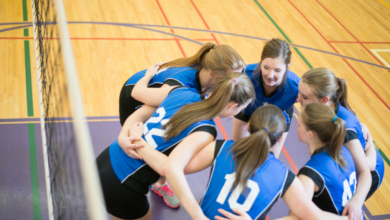Women’s 400m Hurdles: A Complete Guide to Technique, Training, and Top Performances

The women’s 400m hurdles is one of track and field’s most demanding events. You need speed, endurance, strength, technique, and mental toughness all in one race. For many athletes, it is the meeting point of sprinting power and hurdle skill.
In this guide, I aim to walk you through everything you’d want to know: what makes the 400m hurdles unique, how to train for it, how to execute it, and how the best in the world do it. I’ll share research, real examples from elite athletes, and tips you can put into practice whether you are just starting or trying to break into the elite level.
I’ll be honest: I’ve coached or worked with athletes in hurdles, and I’ve seen how small changes in technique or pacing can produce big results. My goal is that by the end of this you’ll feel more confident in designing your training plan or understanding what to focus on next.
2. What Is Women’s 400m Hurdles?
2.1 History & Development
The women’s 400m hurdles is relatively young compared to many track events. The first recorded women’s 400m hurdles races appeared in the 1970s, and it was included in the European Athletics Championships program in 1978, entering the World Championships in 1983 and making its Olympic debut in Los Angeles 1984.
Because it evolved later, the progression in performances was relatively steep at first, before leveling off as athletes optimized training and technique. Over recent decades, female hurdlers have pushed limits in ways many thought unlikely.
2.2 Rules & Specifications
Here are the technical specs and rules (for outdoor track):
-
Distance: 400 metres
-
Number of hurdles: 10
-
Height of hurdles (women): 76.2 cm (30 inches)
-
Spacing: The first hurdle is placed after a run-up, then uniform spacing between hurdles, then a final run-in after the last hurdle.
-
Lane rules: Athletes must stay in their lane for the full race.
-
No knocking over rules (within reason): You can knock a hurdle over if not by deliberate interference, but doing so excessively (or deliberately) is penalized.
-
False start rules: Standard track false start rules apply.
Because the race is a full lap with hurdles, it’s often seen as one of the most grueling events — you’re fighting fatigue, technique breakdown, and race strategy in the same race.
Read Also: Vela olimpiadas Sailing: History, Classes, Rules, and Future of the Sport
3. Records & Top Performances
To understand the ceiling and the benchmarks, let’s look at records and top athletes.
3.1 World Records & Progression
The current women’s 400m hurdles world record is 50.37 seconds, set by Sydney McLaughlin-Levrone (USA) at the 2024 Olympics in Saint-Denis.
Over time, the record has been lowered incrementally as training, sports science, and athlete caliber improve.
The world-leading times in recent seasons are often in the low 51s. For instance, in 2025, the top time was 51.54 seconds by Femke Bol.
Seeing those numbers gives you a target, but also a reminder: to approach 51 or 50 seconds, everything must be almost perfect.
3.2 Top Performances & All-Time List
Here are some notable marks and athletes:
-
Sydney McLaughlin-Levrone still features multiple times on the all-time list with times of 50.37, 50.65, 50.68, etc.
-
Femke Bol (Netherlands) has multiple top times like 51.54 in 2025, and she is world champion as of 2023, 2025.
-
Other elite names include Dalilah Muhammad, Anna Cockrell and rising stars pushing into the low 52s.
In 2025, at the U.S. Championships, Dalilah Muhammad won in 52.65, Anna Cockrell was second 52.89, and Jasmine Jones third at 53.23.
At the 2025 World Championships, Femke Bol won with 51.54, Jasmine Jones got silver, and Emma Zapletalova took bronze with a national record of 53.00.
These performances show how deep and competitive the event is.
4. Biomechanics & Technique
If you want to improve, this is where many gains lie. Technique and small mechanical improvements separate good from great.
4.1 Hurdle Clearance Technique
Clearing the hurdle efficiently is critical. A few key points:
-
Lead leg: Extend the lead leg forward and clear the hurdle with minimal vertical motion. You want a smooth arc, not a big jump.
-
Trail leg: Bring the trailing leg through quickly, ideally bent and tucked, minimizing drag.
-
Torso & posture: Keep your torso low and forward, leaning slightly forward but not bending excessively.
-
Arm action: Use the arms to balance and drive—your arm on the lead side should push forward, the other stabilizes behind.
In a long event like 400m hurdles, fatigue will push your technique to break down late in the race. Rehearsing ideal form under fatigue is critical.
4.2 Stride Patterns Between Hurdles
How many strides you take between each hurdle is a core part of planning your race. Elite women often start with 14 strides between hurdles 1–7, then might shift to 15 strides in later hurdles. This pattern allows them to maintain speed and control.
A 2025 study (Casal-García et al.) looked at how stride patterns have evolved, showing that top performers now often change stride rhythms mid-race depending on fatigue levels and strategy.
As you fatigue, maintaining consistent stride length and cadence becomes hard, so many athletes plan for a shift in stride count near the final hurdles.
4.3 Changes in Elite Technique Over Time
In recent years, elite women have adjusted their stride patterns more dynamically. Instead of rigidly sticking to one stride count, they may adapt as the race unfolds. The 2025 study showed that stride changes correlate with better finishing times when managed correctly.
Also, athletes now emphasize reaction to fatigue, making small adaptations mid-race (shortening or lengthening strides by half-step) rather than making big breaks.
5. Training for Women’s 400m Hurdles
Training a 400m hurdler is tricky: you want to blend sprinting, strength, endurance, technique, and recovery.
5.1 Speed & Sprint Work
You can’t ignore raw speed. Hurdlers still need to run fast between the hurdles. Speed work often includes:
-
Short sprints (60m, 80m, 100m) at near maximum velocity
-
Flying sprints (build into full speed)
-
Speed endurance runs (150m, 200m repeats)
For women’s 400m hurdles, maintaining high speed into the back half is crucial.
5.2 Strength, Power & Plyometrics
Leg strength and explosive power reduce ground contact time and improve force output. Key elements:
-
Squats, deadlifts, lunges (with caution, focusing on quality over load)
-
Olympic lifts (clean, snatch variants) for explosiveness
-
Plyometrics: bounding, hops, depth jumps
-
Core strength and stability (so your hurdle actions stay efficient)
As fatigue sets in, your core and pelvis stability often fail first, so conditioning here is vital.
5.3 Drills & Technical Sessions
Drills connect technique to execution. Useful drills:
-
Low hurdle drills (3-5 hurdles) focusing on clean clearance
-
Lead leg / trail leg isolated drills
-
Hurdle walkovers (slow, emphasis on form)
-
Rhythm drills (e.g. 5 strides between hurdles)
-
Over-distance drills (e.g. 500m with hurdles) to stress endurance
You can intersperse these within speed sessions to reinforce proper mechanics even when tired.
5.4 Sample Training Plan (Weekly / Period)
Here is a rough weekly training structure (for a mid-season phase). Adjust volumes and intensities:
| Day | Focus | Example Session |
|---|---|---|
| Monday | Speed + technique | 4×150m sprints + hurdle technique drills |
| Tuesday | Strength / power | Gym session: squats, cleans, plyometrics |
| Wednesday | Hurdle endurance | 5×200m with hurdles (long rest) + form work |
| Thursday | Active recovery / mobility | Light jog, stretching, hurdle mobility drills |
| Friday | Race simulation | 2×300m hurdle runs + shorter hurdle sets |
| Saturday | Mixed speed + drills | Short sprints + hurdle drills under fatigue |
| Sunday | Rest / regeneration | Full rest or light recovery work |
In the off-season, you’d reduce hurdle volume, emphasize strength, general conditioning, technique foundations.
6. Race Strategy & Tactics
Even with perfect fitness and technique, how you run the race matters hugely.
6.1 Pacing & Energy Distribution
A classic error is going out too fast and breaking down before the finish. For 400m hurdles in women, a good plan might be:
-
First 100m: aggressive but controlled (don’t overdo acceleration)
-
100–200m: settle into rhythm, maintain clearance efficiency
-
200–300m: push but avoid big deceleration
-
Last 100m: all-out, maintain form, overcome fatigue
Top runners may slightly conserve early to have reserves for the final stretch. The key is to avoid “hitting the wall” – when lactic fatigue causes breakdown.
6.2 Mid-race Adjustments & Stride Changes
Mid-race, you might need to adjust stride count or spacing. If your pace slows, you may need to switch from 14 to 15 strides earlier. Anticipating that and practicing flexible stride plans in training helps.
Also, if a competitor gains on you, you may need to accelerate or shorten clearances temporarily.
6.3 Final Hurdles & Finish
The last two or three hurdles are often where races are won or lost. Technique breaks down first here. Maintain:
-
Low clearance (don’t jump high)
-
Quick trail leg
-
Stable posture
-
Relentless drive from your arms and legs
Lean at the line, but don’t do anything that compromises your rhythm before that.
7. Injury Prevention & Recovery
Because of the combination of sprinting and hurdling, the risk of injury is real. But you can manage and reduce it.
7.1 Common Injuries
Common issues among women 400m hurdlers include:
-
Hamstring strains
-
Achilles and calf problems
-
Knee pain or tendinopathy
-
Lower back and hip flexor strain
-
Ankle sprains (from mis-stepping over hurdles)
Because the race stresses the body differently over each hurdle, asymmetries or imbalances often show up under fatigue.
7.2 Preventive Measures
-
Dynamic warm-ups: Always warm up with dynamic drills, mobility, and drills before any volume or speed work.
-
Strength balance: Work on glute, hamstring, hip stability to avoid overloading one side.
-
Flexibility & mobility: Regular stretching, supple hips, ankles, hamstrings.
-
Technique under fatigue: Practice hurdles when tired to simulate race breakdown and teach your body safer mechanics.
-
Load management: Don’t spike volume or intensity too quickly.
7.3 Recovery Tools & Strategies
-
Adequate sleep (7–9 hours or more)
-
Nutrition (protein, carbs, micronutrients)
-
Foam rolling, massage, mobility work
-
Contrast baths / ice, as needed
-
Active recovery (easy jogging, swimming)
-
Scheduled deload weeks
I’ve seen athletes blow out hamstrings simply because they neglected mobility or rushed back from soreness. Investing in recovery pays dividends.
8. Advice for Beginners & Coaches
Here are practical tips if you’re starting or coaching a beginner.
8.1 How Many Strides Between Hurdles (Beginners)
Beginners often use a more conservative stride count (e.g. 16 or 17 strides between hurdles) until they build strength, speed, and consistency. As they progress, they can reduce toward 15 or 14 strides.
Don’t force a too-short stride early – you’ll break down the technique under fatigue.
8.2 Equipment, Hurdle Rules & Setup
-
Use competition-level hurdles at correct height (76.2 cm for women)
-
Practice with hurdle drills before full sessions
-
Ensure consistent hurdle setup and spacing
-
Video your hurdle sessions to identify technical leaks
8.3 Coaching Tips & Progressions
-
Emphasize form early (even over speed)
-
Gradually introduce hurdle volume
-
Use a mix of technical drills and full reps
-
Monitor athlete fatigue – be ready to back off
-
Test and adjust stride plans in training, not just on race day
-
Encourage mental preparation: visualizing the race, rehearsing rhythm
Remember: consistency, patience, and gradual progression win over flash improvements.
9. Personal Observations & Case Studies
Let me share a few observations and examples from top athletes:
Femke Bol (Netherlands) has recently dominated the women’s 400m hurdles. She won the world title in 2025, clocking 51.54 in the final, remaining undefeated all season in the event. She uses a stride plan of 14 between first 7 hurdles, shifting to 15 later, and has improved her finish phase through targeted strength work and technique under fatigue.
Sydney McLaughlin-Levrone, the record holder, shows how far the event can be pushed. Her 50.37 is a testament to combining elite speed, technical efficiency, and breakneck stamina.
Dalilah Muhammad, a two-time Olympic champion and world champion, has also influenced how athletes think about rhythm, stride changes, and fatigue management.
From these cases, you see: to compete at the top, you need not just raw talent, but a strong system of technique, strength, and strategic pacing.
10. Conclusion
The women’s 400m hurdles is a demanding, multifaceted event. It bridges the worlds of sprinting, endurance, agility, and technique. If you want to succeed here, your training must be balanced, your technique sharp, your race plan smart, and your body resilient.
This guide walked you through the event’s history, top performances, technique and biomechanical insights, sample training methods, race strategy, injury prevention, and coaching tips. For a beginner or advanced athlete, the path is similar: build gradually, emphasize consistency, and polish all the small details.
I hope this gives you clarity, inspiration, and actionable steps. If you’d like a version of this article more tailored (for example, for junior athletes, or for coaches), or shorter, or with video clips, just say the word.
Frequently Asked Questions (FAQ)
Q1: What is the world record for women’s 400m hurdles?
A1: The world record is 50.37 seconds, set by Sydney McLaughlin-Levrone in 2024.
Q2: How many strides between hurdles do top women use?
A2: Many elite women use 14 strides between hurdles 1–7, then switch to 15 strides in later hurdles, adjusting if needed mid-race.
Q3: What’s the height of hurdles in women’s 400m hurdles?
A3: The hurdle height is 76.2 cm (30 inches).
Q4: How should a beginner train for women’s 400m hurdles?
A4: Start with basic technique drills, low hurdle clearance work, speed sessions, strength training, and gradually build hurdle volume. Don’t rush stride reductions. Consistency and form matter more early on.
Q5: What are common injuries and how can they be prevented?
A5: Common issues include hamstring strains, calf/Achilles problems, knee pain, back or hip issues. You prevent them with strength balance, mobility, proper warm-ups, gradual loading, and good recovery strategies.



